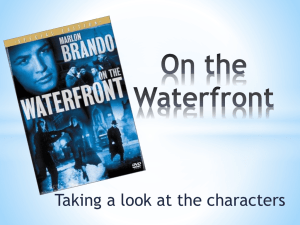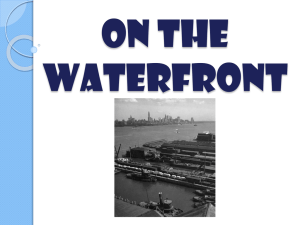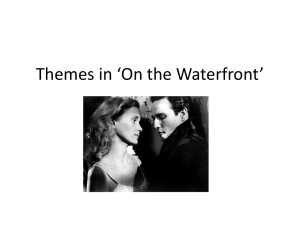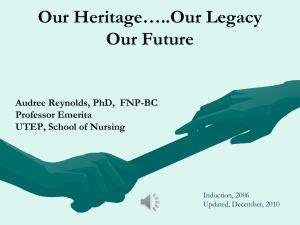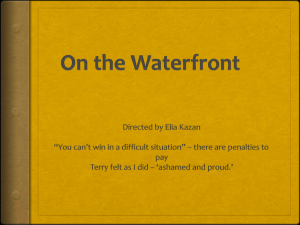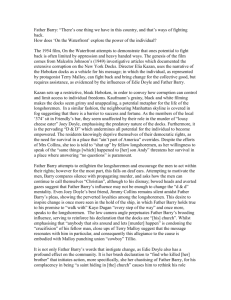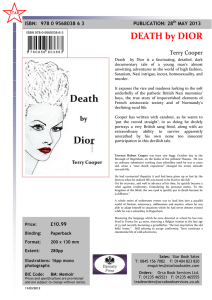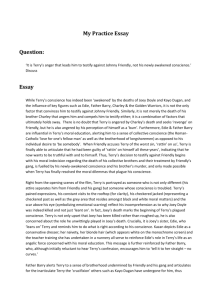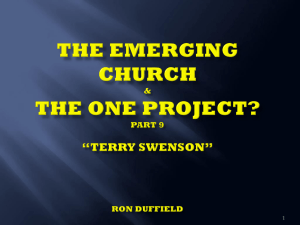On The Waterfront - Year 12 English
advertisement
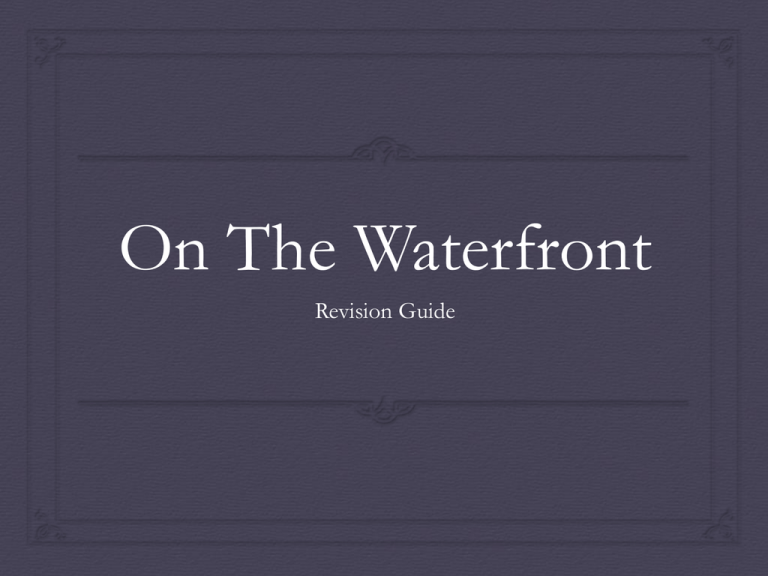
On The Waterfront Revision Guide My Tips for this text… Be really familiar with Terry’s journey of transformation Have a variety of quotes memorised around this Look at the impact of Edie and Father Barry, as well as the significance of other minor characters Have a variety of film-making techniques at your disposal Show Yourself… What do you know? What are the key scenes in Terry’s Journey? Sermon on the docks (he is persuaded by Father Barry) All scenes with the birds Cab scene (I coulda been a contender) He helps Edie escape the church When he finds out Joey has been murdered Confessing to Edie Counting Cash – the guys laugh at him In the pub – Edie challenges his world view Standing up to Friendly on the docks How does the Film-maker show that Terry is to be sympathised with? Use of music – after Joey’s death (check other scenes) Body language – hunched over Softly spoken, mumbles Jacket – he doesn’t fit into the gangsters or the longshoremen His naivety about the murder of Joey The gangsters laugh at him when he counts the cash How important is the connection to McCarthyism? Terry is a projection of Kazan Informing can be a good thing if it is for the right reasons To show the pubic the extent to which people are willing to turn a blind eye if it doesn’t affect them How does the film-maker create the atmosphere of the docks? The medium of black and white film Older clothing Shadows and alleyways Lots of people, they are made to look small Skyline shows New York and Manhattan skyline (out of reach) Hectic music Use of real dockworkers in the crowd Who challenges Terry’s view of the world? Edie – literally Father Barry Charley – gives him on opportunity to reflect on himself Johnny Friendly – in his formative years? The cops How is Father Barry responsible for Terry’s changes? Appeals to his conscience Tells the workers to stand up for themselves – and provides the example for this in the sermon on the docks. Where are the key turning points in the text? Sermon on the docks (Terry punches the gangster) Talks to Edie after escaping the church Choosing to take Edie home over answering Friendly’s call Cab scene Dockworkers come to support Terry – who walks into work Who else is transformed in the text? Dugan – becomes a hero ready to stand up to the Union Father Barry – Edie inspires him to take an interest and make a difference Charley – finally does the right thing by Terry Johnny Friendly – defeated – has to face his fear of being a nobody Pop Doyle – goes from “Deaf and dumb” to standing up for his rights (and pushing Friendly into the water) How does the film explore the difficulty in determining right from wrong? Black and white filming – represents two distinct sides Fear – should not determine your actions, rather your conscience Is it right to protect your friends or follow your conscience? Terry’s difficulties are different to the other longshoremen – its not fear but loyalty Why is the film in black and white? To convey that the world that they are living in is black and white (Terry didn’t view it this way – he wanted to be good but was doing bad things) Lends it a sense of being documentary How are the characters trapped in a cycle of the sameness? If no one makes change, change doesn’t occur Takes more than one person to create change Deaf and Dumb mentality Fear of opposing the Union Fear of loss of work and livelihood Father Barry hid in his church How is Edie portrayed an angelic? White hair White gloves Beautiful – inner and outer Innocence Naivety Conviction Kind to strays (shows a caring nature) Studies with the nuns How is Terry established as an outsider? Clothes Doesn’t walk with the rest of the group Sits apart of the longshoremen in the church Both groups tease him Prefers pigeons to people Hangs out with the young people What is significant about the Contender scene in terms of the plot? Both Charley and Terry express an understanding for their faults Terry admits who and what he is Charley finally realises he has done wrong by Terry Beginning of the metaphor of sacrifice in the text What are the values of the longshoremen? Mateship/Comraderie Look after each other when they are in need You don’t rat How does the film explore the redemptive power of love? Charley gives him a chance because he loves him Edie believes in him – makes him think he is capable of good things Father Barry shows him a greater love and a love for all men. Discuss references to birds in the text? Terry shows sensitivity Freedom Hierarchy on the waterfront (Hawks and pigeons metaphor) Simpler life They represent values Terry admires An individual can/not create change. Discuss. This is all about how you view the ending. Yes but they need help from others (Terry doesn’t create change until he wins over the other longshoremen) Its really Edie who creates change – but she does it by influencing those in a position to make change The Mr Upstairs scene shows us how far the system goes – and that Terry has only broken down one aspect of it that can be easily replaced. Individual change has to precede collective change How is boxing important to the text? Its about fighting and the fighting spirit. Getting up when you have been knocked down. Standing up for what you believe in. It represents a Terry with a future and potential – which he rediscovers. It also represents his pride – after taking a dive this is severely damaged. Terry replays the “dive” by beating up Johnny Friendly (standing up for himself). The longshoreman remark that he still fights like he used to. Could Johnny Friendly be considered a victim too? Friendly also grew up in this system and had to provide for his family. He now has to struggle and be ruthless in order to protect the power base he has built for himself. He is not inhuman – he takes Terry under his wing. The Mr Upstairs scene shows that he isn’t really the one with all the power. How do you interpret the ending? The individual triumphs over the system. Pride is returned to the longshoremen Terry brings down Johnny Friendly – but what is coming next? He cant change the system. Ambiguous or hopeful? Shows what real leadership is – suffering for your people (Christ-like)

